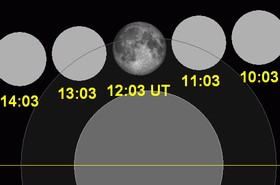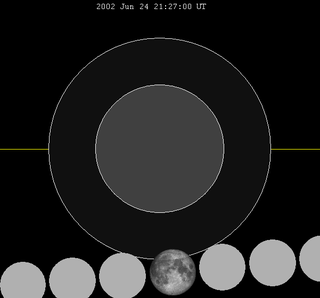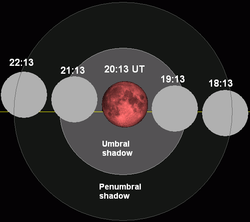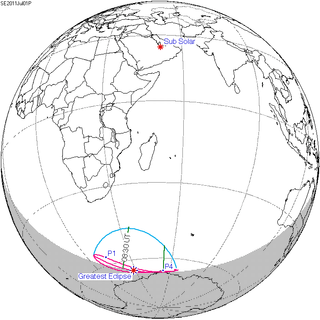Eclipse season
An eclipse season is one of only two periods during a year when eclipses can occur, due to the orbital inclination of the Moon. Each season lasts for approximately 34 days and repeats just short of six months, thus two full eclipse seasons always occur each year. Either two or three eclipses happen each eclipse season. During the eclipse season, the inclination of the Moon's orbit is low, hence the Sun, Moon, and Earth become aligned straight enough (in syzygy) for an eclipse to occur.
During each season, the type of solar eclipse (whether total or annular, as seen from the sublunar point) depends on the apparent sizes of the Sun and Moon, which is a function of the elliptical distance of Earth from the Sun and of the Moon from Earth, respectively, as seen from Earth's surface.
If the Earth had a perfectly circular orbit centered around the Sun, if the Moon's orbit was also perfectly circular and centered around the Earth, and if both orbits were coplanar (on the same plane) with each other, then two eclipses would happen every lunar month (29.53 days). A lunar eclipse would occur at every full moon, a solar eclipse every new moon, and all solar eclipses would be the same type.
Details
An eclipse season is the only time during which the Sun (from the perspective of the Earth) is close enough to one of the Moon's nodes to allow for an eclipse to occur. During the season, whenever there is a full moon a lunar eclipse will occur and whenever there is a new moon a solar eclipse will occur. If the Sun is close enough to a node, then a total eclipse will occur. Each season lasts from 31 to 37 days, recurring about every 6 months. At least two (one solar and one lunar, in any order), and at most three eclipses (solar, lunar, then solar again, or vice versa), will occur during every eclipse season. This is because it is about 15 days (a fortnight) between full moon and new moon and vice versa. If there is an eclipse at the very beginning of the season, then there is enough time (30 days) for two more eclipses.
In other words, because the eclipse season (34 days long on average) is longer than the synodic month (one lunation, or the time for the Moon to return to a particular phase and about 29.5 days), the Moon will be new or full at least two, and up to three, times during the season. Eclipse seasons occur slightly shy of six months apart (successively occurring every 173.31 days - half of an eclipse year), the time it takes the Sun to travel from one node to the next along the ecliptic. If the last eclipse of an eclipse season occurs at the very beginning of a calendar year, it is possible for a total of seven eclipses to occur since there is still time before the end of the calendar year for two full eclipse seasons, each having up to three eclipses.[1][2][3]
Examples
Visual sequence of two particular eclipse seasons
In each sequence below, each eclipse is separated by a fortnight. The first and last eclipse in each sequence is separated by one synodic month. See also Eclipse cycles.
| May 26th Descending Node (Full Moon) | June 10th Ascending Node (New Moon) | June 24th Descending Node (Full Moon) |
|---|---|---|
 |  |  |
| Penumbral lunar eclipse Lunar saros 111 |
Annular solar eclipse Solar saros 137 |
Penumbral lunar eclipse Lunar saros 149 |
| June 1st Descending Node (New Moon) | June 15th Ascending Node (Full Moon) | July 1st Descending Node (New Moon) |
|---|---|---|
 |  |  |
| Partial solar eclipse Solar saros 118 |
Total lunar eclipse Lunar saros 130 |
Partial solar eclipse Solar saros 156 |
(The two eclipse seasons above share similarities (lunar or solar centrality and gamma of each eclipse in the same column) because they are a half saros apart.)[4]
Two-year chart of eclipses (2013–2014) demonstrating seasons
| Date | Type (phase) | Time of season | next eclipse will occur... |
|---|---|---|---|
| April 25, 2013 | lunar (full) | beginning | next new moon |
| May 10, 2013 | solar (new) | middle | next full moon |
| May 25, 2013 | lunar (full) | end | next eclipse season |
| ... no eclipses for about 5 months... | |||
| October 18, 2013 | lunar (full) | beginning | next new moon |
| November 3, 2013 | solar (new) | end | next eclipse season |
| ... no eclipses for about 5 and a half months... | |||
| April 15, 2014 | lunar (full) | beginning | next new moon |
| April 29, 2014 | solar (new) | end | next eclipse season |
| ... no eclipses for about 5 and a half months... | |||
| October 8, 2014 | lunar (full) | beginning | next new moon |
| October 23, 2014 | solar (new) | end | next eclipse season (spring of 2015) |
The partial lunar eclipse of August 7-8, 2017 was followed by the solar eclipse of August 21, 2017.
See also
References
- ↑ Littmann, Mark; Fred Espenak; Ken Willcox (2008). Totality: Eclipses of the Sun. Oxford University Press. pp. 18–19. ISBN 0-19-953209-5.
- ↑ Periodicity of Lunar and Solar Eclipses, Fred Espenak
- ↑ Five Millennium Catalog of Lunar and Solar Eclipses: -1999 to +3000, Fred Espenak and Jean Meeus
- ↑ A Catalogue of Eclipse Cycles, Robert Harry van Gent